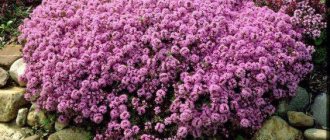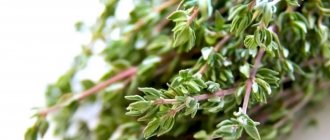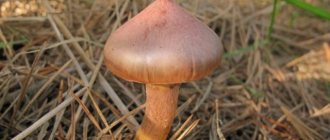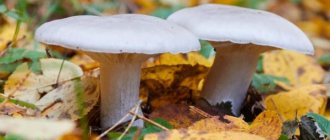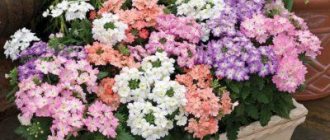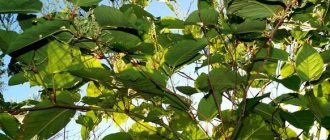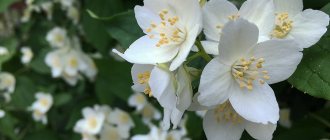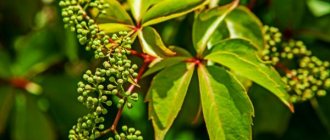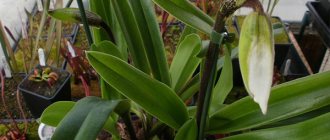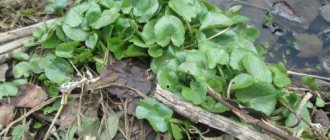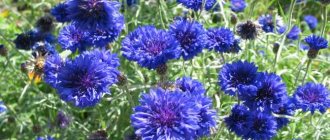- Thyme or thyme: plant description, cultivation and use
- What is thyme or thyme like?
- Conditions and care for thyme and thyme in the garden
- How thyme and thyme overwinter
- Using thyme or thyme
- Thyme in landscape design
- Thyme in cooking
- Bogorodskaya herb in folk medicine
- Propagation of thyme and thyme
- You can take thyme or thyme in natural conditions
- Video: thyme or thyme - how to grow from seeds
Thyme or thyme: plant description, cultivation and use
Thyme or thyme or Bogorodskaya herb Which is correct? And it is correct in any way, because under these names the same plant “passes”, more precisely, one genus of plants (Thymus) from the Lamiaceae family. There are many other folk names associated with the amazing property of this low shrub to release a large amount of aromatic substances. Thyme is considered one of the most important essential oil crops. The cultivation of thyme and its use in landscape design, cooking and medicine will be discussed in this article.
Thyme or thyme is fragrant, healthy and decorative.
What is thyme or thyme like?
The Thyme genus includes several hundred species, distributed in the temperate climate zone of Europe, Asia and North Africa.
This is a low, from 10 to 40 cm, perennial evergreen shrub. A characteristic feature of thyme is its soft, herbaceous stems lying on the ground and only slightly rising. It grows in breadth, not upward, and often quite actively conquers the space around it.
As they grow, the stems become woody. Due to the fact that there are too many types of thyme, it is not easy to describe it. For example, leaves can be round, oval, elongated, oblong, sometimes jagged. But they are always hard and small (up to 1 cm).
Thyme blooms in summer with small white, pink or purple flowers. The beauty of thyme is that from a small piece it quickly grows into a whole clump, forming a dense cushion. And the slightest touch to it causes an explosion of smell. Despite the fact that it will not require any care from you, but will bring a lot of benefits.
Thyme or thyme is a low, from 10 to 40 cm, perennial evergreen shrub.
Medicinal properties
The rich composition in itself does little to attract the average lover of natural medicine. Much more important is how these components accumulate and help a person cope with illnesses. Here we will touch on the practical benefits of this plant in more detail.
Note that thyme is used not only in medicine; the absence of symptoms of disease does not mean that you cannot brew tea with thyme, for example, or add it to a confectionery masterpiece.
- Reduces pain. The decoction is often recommended for those who do not want to take pills for headaches or stomach pain.
- Clears the stomach of toxins. Tea is useful for drinking for people who periodically consume alcohol and tobacco.
- Fights viruses and mild strains of bacteria. This happens due to organic acids, including vitamin C.
- Expectorant properties. Thyme, along with sage, is an excellent sore throat remedy.
- Calms the nerves. In stressful situations, it is useful to drink tea with thyme; it restores mental sobriety, normalizes the functions of the central nervous system, and gives strength to implement plans.
Each person on this list will find something important and necessary for themselves. But it is worth highlighting the unique properties of thyme to treat narrowly targeted diseases of men, women and children.
- For men. Many middle-aged men suffer from sexual weakness or dysfunction. The plant normalizes blood function and its flow to the genitals. The course is not quick; within 2-3 months you will need to replace classic black tea with tea with natural thyme.
- For women. Women who experience severe pain during menstruation should also pay attention to thyme essential oil. The plant, as noted earlier, actively affects the blood and nervous system.
- For children. Little children under 7 years old do not sleep well, the problem is physical growth and hormonal activity. Tea with this herb before bed will give your child a restful and healthy sleep.
The medicinal properties of this plant will reveal themselves even better if you turn to the recipes of the folk health resort, which we’ll talk about right now, fix a few recipes for yourself, they will come in handy.
Conditions and care for thyme and thyme in the garden
“No” is, of course, a strong word. Killing him is difficult, but possible, so it's worth knowing a few things about him.
Firstly, thyme or thyme should be planted in open, well-lit and warm places. Only there will it grow well, look attractive and accumulate essential oils as much as possible.
It will survive in shade or partial shade, but the stems will stretch out and there will be no flowering, and there will be less smell.
It should not be planted on oily, manured, or overly fertile soils. After all, if we remember its natural needs, it settles and grows on rocky slopes, in steppes and even deserts, where, frankly speaking, there is no smell of manure. So, if you have soil on your plot that you are proud of and that produces excellent cucumbers, tomatoes and potatoes, you will have to artificially deplete it to grow thyme.
How? Just add a large amount of sand into the hole and around when planting. On the one hand, this will reduce fertility, and on the other, it will make the soil drained. After all, another problem for thyme is stagnation of water. The plant is drought-resistant and, by and large, does not need watering - the water should quickly leave the root zone.
It is believed that acidic soils are not suitable for thyme; it is a fan of neutral or slightly alkaline soil. But very often thymes are found on the edges of pine forests, where the soil is slightly acidic. So there are likely differences depending on the specific species.
Perhaps it’s worth adding that to give the bushes a more pleasant appearance, you should either actively pinch them, remove the ends of the branches, or trim them. But I love using thyme as a seasoning so much that I don’t even have to trim it.
Creeping thyme: beneficial properties of the plant
Thyme was known for its beneficial properties in ancient times - Avicenna, Hippocrates and Theophrastus wrote about it. The Egyptians used thyme when embalming their rulers.
Today, thyme is widely used in official and folk medicine to treat many diseases.
The thyme plant is a storehouse of useful elements and vitamins C and B. The herb is used as a powerful anti-inflammatory and antiseptic agent, thanks to the cavacrol it contains. Before the advent of antibiotics, herbal infusions were used as a powerful antiseptic.
Thyme has many beneficial properties:
- Improves the functioning of the digestive system - helps with severe flatulence, bloating, intestinal colic and intestinal disorders;
- Regular consumption of tea from this herb improves appetite and digestion;
- It has an expectorant effect, so herbal decoctions are used for bronchitis, tracheitis and common colds;
- Tea made from it is an excellent remedy for nervous disorders and depression, calms the nervous system, improves sleep;
- Good for men's health - prevents the development of prostatitis, helps increase male libido;
- Rinsing with a decoction of dried thyme helps relieve inflammation of the gums and strengthens them;
- As a compress, dried thyme helps fight rheumatism, arthrosis and gout;
- For severe migraines, a pillow of dried herbs lying next to the bed will help;
- Increases lactation, but using the decoction requires consultation with a doctor;
- Removes toxins, cleanses the liver in case of severe alcohol poisoning.
It is best to harvest thyme in the first half of June, when the grass has not yet been dried by the scorching sun and contains many beneficial essential oils. The stems of the plant are cut off at the root and dried in a ventilated place away from direct sunlight.
How thyme and thyme overwinter
Well, many are probably worried about the question: “Will thyme survive our harsh winters?” We are used to seeing thyme in the “Mediterranean herbs” seasoning and think that the plant is “from there”. Nothing like that, there are ours, and they are even very frost and winter hardy. Most species can withstand frost down to -25...-28 degrees, and even more so with snow (the plant is low and the snow covers it well).
My thyme is coming back to life after winter.
Using thyme or thyme
Thyme in landscape design
Evergreen, low and fragrant thyme cushions can be used to create borders along garden paths. It can be planted in the foreground of a flower bed, because, in addition to the green foliage, it also blooms beautifully, abundantly and for a long time (all summer).
God himself ordered that thyme be included in the composition of spicy and aromatic beds, and it will also work in apothecary gardens. You can grow it in pots and cache-pots, or as a ground cover plant. Many varieties of thyme “spread” quickly and form a fairly dense covering, from under which it is difficult for weeds to break through.
Remembering, again, its natural habitats, thyme can be a plant for rocky hills, rockeries, rock gardens... Call it what you want, but thyme goes well with stone.
Roses look very interesting, under which there is a continuous carpet of thyme. If you are keen on growing bulbous primroses, then feel free to plant thyme on top of them. They will break through the thyme mat and will look impressive against its background, despite the fact that their foliage disappears quickly after flowering.
Types of thyme
Thyme has more than 200 varieties. Many plant species have been cultivated; therefore, thyme is grown as house plants and medicinal raw materials. In addition, some species are hybridized and grow only in garden conditions.
Common thyme (Thymus vulgaris), or medicinal thyme, or officinalis thyme
The most popular variety that grows equally well both in the natural environment and in artificially created conditions. It is a low-growing creeping shrub, the height of which does not exceed 15 cm. The plant has long creeping stems branching in different directions. The stems and inner side of the foliage of this species are covered with hairs.
Common thyme blooms with purple inflorescences. Flowering occurs at the end of summer. There is an abundance of flowers, which gives the plant an unusual appearance and high decorative characteristics.
Common thyme has been cultivated; several varieties of this species have been developed:
- Alba is a perennial plant with white, lush flowers. The diameter of the inflorescences is up to 7 cm;
- Splendence is a decorative representative of thyme, the inflorescences of which have red shades;
- Elfin is a hybrid, which is a low-growing variety of thyme. The height of the bushes does not exceed a centimeter. The plant spreads along the ground and forms a dense fibrous surface, similar to canvas.
Different varieties are often planted together, as a composition of different shades and sizes helps complement the background of the garden and create a comfortable atmosphere in the area.
Creeping thyme (Thymus serpyllum)
Siberian representative of thyme. The plant is perennial, common in the steppe zone and the Far East. Thyme is a perennial plant with creeping stems. The stems of the variety are quite dense, colored in burgundy-brown shades. The stems are creeping, spread along the ground, and do not exceed 15 cm in height. The lower part of the shoots is fleecy.
Creeping thyme has oblong leaves with smooth edges. The length of the leaf plate is about a centimeter. The leaves are smooth on top and covered with fine hairs below. They are located opposite each other on the stem. A network of veins is clearly visible on the surface of the leaf.
It blooms in late July - early August with white or purple inflorescences up to 2 cm in diameter. The flowers are small, cylindrical. After flowering, fruits with brown seeds form in place of the buds.
Early thyme (Thymus praecox)
A cultivated variety of thyme, the peculiarity of which is its early flowering. The plant naturally grows on mountain slopes and rocky embankments. In an artificial environment, the variety is planted on alpine hills.
It is a small perennial shrub plant, up to 20 cm high. The peculiarity of the variety is its long, erect shoots, at the ends of which inflorescences form. At the same time, the foliage is located mainly at the bottom of the bush.
The castings are located parallel to each other. The leaves are smooth, small, and do not exceed 2-3 cm in diameter. The surface of the leaf blade is pubescent. The edges of the leaves are smooth. The color of the leaf blade is rich green.
The variety has two varieties that differ in the color of the buds and the flowering period. Thus, they distinguish thyme “Minor”, which grows slowly and blooms for a long time with purple inflorescences. They also distinguish the variety “Pseudolanuginosus”, which is represented by a dwarf bush that covers the density of the earth with thick green leaves with small lilac flowers.
Lemon thyme (Thymus x citriodorus), or lemon-scented thyme
A hybrid representative of common thyme. A perennial shrub-type plant, up to 30 cm high. The plant is found naturally in the south of France. Where the first variety was bred. It blooms with light pink buds, up to 3 cm in diameter.
The perennial has bright green leaves of an oblong shape with smooth edges and a smooth surface. The leaves are located along the entire stem parallel to each other. The leaves are petiolate. When grown in a garden, the plant requires additional care and regular pruning of shoots and foliage.
Subarctic thyme (Thymus subarcticus)
A perennial representative that is found in subarctic areas. It grows mainly along river banks and in rocky areas. The plant is a low-growing creeping shrub. Blooms with dark pink flowers. The height of the bush does not exceed 25 cm. Thyme is covered with dense foliage of an oblong shape. The leaves are quite large, up to 5 cm in length. There are prominent veins on the surface of the foliage. The edge of the leaf plate is smooth and curves back. The plant emits a strong and pleasant odor that attracts insects necessary for pollination.
Thyme in cooking
The next use of thyme is for our table. Thyme leaves and sprigs are an excellent seasoning for meat dishes (for me, in second place after rosemary), mushrooms, cottage cheese, fish and even cheeses and sweet dishes.
Thyme or thyme can be used to make drinks, add to salads and pickling mixtures, bake bread, make aromatic vinegar, or simply add to tea. Moreover, the leaves can be taken fresh or dried.
But why dry them? After all, thyme is a great plant to grow in a pot on the kitchen windowsill - all year round, in any climate, reach out and pick the end of a sprig with a few leaves.
Bogorodskaya herb in folk medicine
What about the health benefits? It is also available. Thyme, or rather the substances contained in its shoots and leaves, is used as a disinfectant, analgesic, anthelmintic and expectorant. Remember "Pertussin"? It's made from thyme. Moreover, you can use both fresh raw materials and prepared (dried) ones.
Thyme or thyme can be infused in alcohol and used for rheumatism, or you can take baths with a decoction of thyme for radiculitis. And just sitting in the evening near a thyme bush, lightly touching it and inhaling its aroma... It calms me down.
Well, where can you get it and how can you place it on your property? There are several breeding options.
Thyme or thyme can be successfully grown on kitchen windowsills.
Interesting facts about the plant
Despite the fact that thyme is quite popular in medicine and is often used as an antiseptic, not one type of microbe can develop resistance to the herb. Therefore, the quality of using the plant is still at its best.
In the ancient world, thyme was used as an offering to the gods. At the same time, believers inhaled the vapors of burning thyme, believing that in this way God would better hear their prayers.
In some countries, thyme is still considered a raw material for increasing male power. Therefore, men often take baths with herbs and use the drug internally.
Propagation of thyme and thyme
Propagation of thyme by seeds. They are simply sown in the spring, directly into open ground. You can, of course, build a greenhouse, but usually thyme seeds germinate that way. Moreover, they often bloom already in the first year of life. Often, however, you have to wait a long time for seedlings, and the weeds may be quicker.
Reproduction by dividing the bush. If there is a familiar donor bush, then in the spring or autumn it can be dug up and divided into parts. It is desirable that each division has at least some roots. With proper care (watering), the new bushes take root well.
Propagation of thyme by rooting cuttings. Any sprig of thyme is pressed to the ground with a pebble, wire, or slingshot and soon produces roots. All that remains is to carefully dig it up and separate it from the mother bush. In this way, it is good to expand an existing thyme bush over a larger area.
Propagation of thyme by cuttings. You can simply cut the branches and dig them lightly into the ground, leaving the part with the leaves on the surface. You just need to regularly moisten the soil in such a “school”.
Proper preparation of thyme
Thyme has pronounced medicinal properties. However, in order to preserve the benefits of the herb in winter, it is worth harvesting the plant correctly.
Collection
The collection of raw materials is carried out in spring or summer, while the grass is young. Collection is carried out in dry weather, after the grass has been in the sun for a long time. Some doctors advise harvesting the herb in the morning, since at this time the plant is saturated with a large amount of useful substances.
You can collect thyme immediately in bushes or separately, separating parts of the grass. To prevent injury to the roots, the raw material is cut from the mother plant. Thus, the mother retains her qualities and will be useful next year.
Drying
The raw materials should be dried in a well-ventilated area, in the absence of sunlight. The best place for drying is the attic or vegetable drying rack. The layer should be turned over periodically to ensure even drying of the grass.
Storage
After drying the herb, the thyme is placed in a dry paper or fabric bag. It is also appropriate to store thyme in a box or glass jar with a lid. Store the herb in a cool, dry place. Shelf life is about 3 years.
